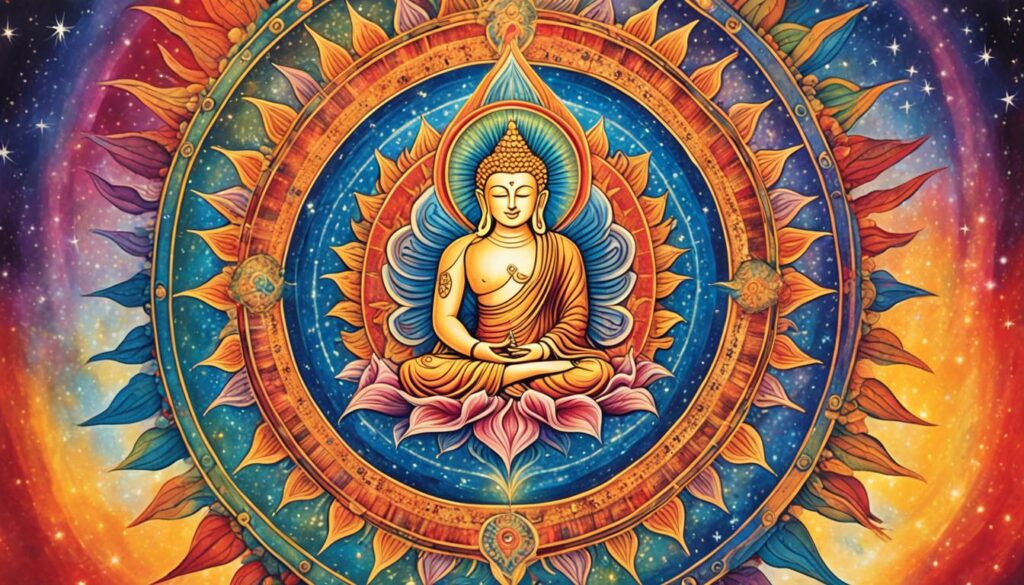Have you ever wondered what Tantric Buddhism is all about? Is it just an esoteric and mysterious practice, or is there something more to it? What is the role of tantra in Buddhism, and how does it relate to the path of awakening? Let’s delve into the world of Tantric Buddhism and uncover its transformative power and profound insights for personal and societal harmony.
Tantric Buddhism is based on the belief that liberation can be achieved without renouncing worldly responsibilities. It offers a unique perspective on transforming conflicting emotions into transcendental wisdoms that lead to liberation.
The famous Kalachakra Tantra, taught by Buddha Shakyamuni, is a symbol of the transformative power of tantric Buddhist teachings. This ancient text emphasizes the interconnectedness of all beings and the potential for awakening in every moment.
Tantric practices often involve mantras, visualizations, and ritual gestures called mudras. However, it is the genuine devotion and faith in these practices that are believed to be truly transformative. Tantric Buddhism views conflicting emotions as temporary forms of natural wakefulness, and through the practice, these emotions can be transformed into transcendental wisdoms that lead to liberation.
Key Takeaways:
- Tantric Buddhism offers profound insights for personal and societal harmony.
- It is based on the belief that liberation can be achieved without renouncing worldly responsibilities.
- The transformative power of tantra lies in its view of all-pervading sacredness.
- Tantric practices involve mantras, visualizations, and ritual gestures.
- Genuine devotion and faith in tantric practices are key to transformation.
The Power of Tantric View
The transformative power of tantra lies in its unique perspective known as the tantric view. This view recognizes the inherent sacredness and wakefulness in everything, including our emotions. According to tantra, ordinary emotions such as desire, anger, pride, and jealousy are actually confused forms of natural wakefulness. Rather than suppressing or avoiding these emotions, tantra teaches that they can be transformed into wisdom.
Tantra views conflicting emotions not as obstacles but as temporary expressions of natural wakefulness. By embracing these emotions and working with them through tantric practices, individuals can harness their transformative potential and cultivate wisdom. This shift in perspective allows practitioners to navigate their emotional landscape with greater awareness and understanding.
Furthermore, the tantric view extends beyond our emotions to encompass all phenomena. It recognizes the freedom and indestructible nature of all things, leading to the realization that everything is unconditionally free from concepts and projections. This perspective of boundless sacredness allows practitioners to experience a profound sense of interconnectedness and liberation.
Ultimately, it is through adopting the tantric view that the transformative power of tantric Buddhism is fully realized. By embracing the inherent sacredness of all aspects of life, practitioners can embark on a path of profound spiritual growth and awakening.

The Transformative Power of Tantra
- Embracing conflicting emotions as forms of natural wakefulness
- Transforming emotions into wisdom through tantric practices
- Acknowledging the freedom and indestructible nature of all phenomena
- Realizing the unconditional freedom from concepts and projections
- Experiencing interconnectedness and liberation through the tantric view
The Practice of Tantra
Tantric practice is a multifaceted spiritual journey that encompasses various techniques aimed at deepening your understanding of the tantric view. Through the use of mantras, mudras, and visualizations, practitioners can tap into the transformative power of tantra and cultivate a profound connection with their own awakened nature.
Mantras: Sacred Syllables for Transformation
One of the key practices in tantra is the recitation of mantras, which are sacred syllables or phrases that are charged with the power of true nature. By repeating these mantras with devotion and intention, practitioners can unlock the spiritual essence within themselves and connect with the divine. Mantras have a profound effect on the mind, purifying and transforming negative emotions into positive qualities such as compassion, wisdom, and inner peace.
Mudras: Ritual Gestures for Awakening
Another integral aspect of tantric practice is the use of mudras, which are ritual gestures performed with specific hand positions. These mudras embody the qualities of awakened body, speech, and mind, and serve as a physical expression of our spiritual aspirations. By practicing mudras, we align our physical bodies with our inner wisdom and connect with the transformative power of tantra at a profound level.
Visualizations: Direct Experience of Enlightenment
Visualization is a powerful technique in tantric practice that enables practitioners to directly experience themselves as enlightened beings and dissolve the boundaries between self and others. Through visualization, we tap into our innate potential and cultivate a deep sense of interconnectedness with all beings. This practice not only enhances our capacity for compassion and loving-kindness but also nurtures a sense of vajra pride, allowing us to embody the wisdom and power of tantra in our daily lives.
By incorporating mantras, mudras, and visualizations into your spiritual practice, you can embark on a transformative journey of self-discovery and awaken to the profound wisdom and power of tantra.
Tantra as a Path to Awakening
Tantra offers a transformative path to awakening that encompasses three vital dimensions: ground tantra, path tantra, and fruition tantra. Each dimension holds its own significance in the journey of self-realization and spiritual growth.
Ground Tantra: Recognizing the Wakeful Nature of All Phenomena
The first dimension, ground tantra, is the recognition and realization that all phenomena arise from wakeful nature and are inherently workable. This understanding opens the door to a profound shift in perception, enabling practitioners to bring every aspect of their lives, from the best to the worst moments, onto the path of awakening. Ground tantra allows us to embrace the full spectrum of human experience and transform it into wisdom and compassion.
Path Tantra: Engaging in Transformative Practices
Path tantra involves actively engaging in practices and experiences that lead to realization. Through the utilization of mantras, mudras, visualizations, and other tantric techniques, practitioners deepen their understanding of the tantric view and cultivate qualities such as compassion, wisdom, and clarity. Path tantra provides a structured framework for personal growth and empowers individuals to navigate the challenges of life with grace and resilience.
Fruition Tantra: Realizing Your Buddha Nature
The ultimate aim of tantra is fruition tantra, the realization of one’s buddhanature. Fruition tantra represents the culmination of the tantric path, where profound insight and wisdom are fully integrated into one’s being. It is the complete manifestation of our inherent potential to become a buddha, embodying boundless compassion, wisdom, and enlightened qualities. Fruition tantra holds the promise of ultimate liberation and the ability to contribute to the well-being of all beings.

Through the tantric path, practitioners embark on a transformative journey of self-discovery and spiritual evolution. Ground tantra provides the foundation, path tantra offers the means, and fruition tantra represents the pinnacle of realization. By embracing the profound teachings and practices of tantra, individuals can unlock their true potential and embark on a path of awakening that leads to deep fulfillment and inner liberation.
Tantra and Relationships
Tantra recognizes the profound significance of relationships in the journey of spiritual awakening. In the realm of tantra, relationships are not seen as mere companionships but are revered as gateways to self-discovery and healing. Tantric relationships, particularly intimate partnerships known as tantric consorts, hold a sacred space within which practitioners can explore the depths of their being and forge a profound connection with the entire phenomenal world.
Through the practice of engaging in a tantric consort relationship, individuals embark on a transformative journey of self-discovery and deep love. Tantra teaches us how to love deeply, to embrace vulnerability, and to open our hearts to the vastness of the universe. By cultivating a deep level of connection and unconditional love, practitioners can heal core traumas, resolve deep wounds, and experience profound fulfillment, joy, and union with all creation.

The Power of Intimacy in Tantra
In tantra, intimacy goes beyond physical closeness; it delves into the realm of the soul. By nurturing a harmonious and authentic connection with a tantric consort, individuals can explore the depths of their being, shedding layers of conditioning, and experiencing profound growth and healing. This level of vulnerability, trust, and emotional intimacy creates a fertile ground for transformation and spiritual evolution.
A Sacred Union
The tantric consort relationship is regarded as a sacred union that expands beyond the limitations of individual identities. It represents the unity of masculine and feminine energies, embodying the principles of balance and wholeness. Through this sacred union, practitioners embrace the paradox of duality and dissolve the boundaries between self and other, laying the foundation for spiritual realization.
Healing and Transformation
The consort relationship offers a unique path to healing and transformation. By creating a safe and supportive space, tantric consorts can guide each other in exploring their deepest fears, insecurities, and wounds. Through this shared journey of healing, individuals can release past traumas, cultivate self-acceptance, and embrace their authentic selves. The consort relationship becomes a catalyst for personal growth, healing, and spiritual awakening.
Expanding Consciousness
Within the tantric consort relationship, the boundaries of individual consciousness are transcended. The profound connection between consorts allows for the transmission of spiritual energies and the exploration of altered states of consciousness. Through practices such as tantra and intimacy, individuals can expand their awareness, access higher realms of consciousness, and experience a deep sense of interconnectedness.
Sacred Rituals and Practices
Within the context of a tantric consort relationship, various sacred rituals and practices are explored to deepen the spiritual connection and enhance the transformative power of the relationship. These may include tantric meditation, breathwork, sensual exploration, and energetic practices. Together, consorts create and participate in rituals that amplify their mutual spiritual growth, creating a profound and sacred shared space.
Embrace the transformative power of tantric relationships and embark on a journey of self-discovery, healing, and spiritual awakening. Through the sacred union with a tantric consort, you can experience profound love, expansion of consciousness, and a deep connection with the divine and all creation.
| Benefits of Tantra in Relationships | Practices for Deepening Intimacy |
|---|---|
|
|
The Role of the Teacher in Tantra
In the tantric tradition, the role of the teacher is crucial. The teacher serves as a guiding light, leading students on the path of awakening and empowering them through various practices and rituals. Through the relationship between the teacher and student, profound transformations can take place.
An essential practice in tantric Buddhism is guru yoga. Guru yoga is a sacred practice that forms a bond between the teacher and the student, based on devotion and trust. It involves recognizing the teacher as an embodiment of enlightened wisdom and cultivating a deep connection with them. By engaging in guru yoga, the student opens themselves up to receive the blessings and guidance of the teacher, accelerating their spiritual journey.
The samaya bond is another crucial aspect of the student-teacher relationship in tantra. Samaya refers to the sacred commitments made by the student to maintain a pure view of the teacher and fellow disciples. These commitments are rooted in integrity and respect, fostering an environment of trust and spiritual growth.
Additionally, the teacher plays a vital role in transmitting sacred knowledge through reading transmission. Reading transmission involves the teacher authorizing the student to recite sacred texts, granting them access to the wisdom contained within. The teacher also provides practical instructions on meditation and visualization techniques, ensuring the student’s practice is grounded and effective.
Through their guidance, the teacher introduces students to the tantric view, imparting wisdom and empowering them on their path of awakening. The teacher-student relationship in tantra is a sacred and transformative bond, igniting the inner fire of realization and guiding seekers toward enlightenment.

Elements of the Student-Teacher Relationship in Tantra
| Element | Description |
|---|---|
| Guru Yoga | A practice that forms a bond between teacher and student, based on devotion and trust. |
| Samaya | The sacred commitments made by the student to maintain a pure view of the teacher and fellow disciples. |
| Reading Transmission | The teacher authorizes the student to recite sacred texts and provides practical instructions on meditation and visualization. |
The Transformative Power of Tantra Today
Contemporary tantra is not limited to ancient times but continues to thrive in our modern society. Today, practitioners are uniquely positioned to embark on a profound spiritual journey through the application of tantric teachings in their everyday lives.
Modern tantric practice offers a path to self-discovery and growth through intimate relationships, serving as a gateway to profound transformation. Tantra allows individuals to integrate its principles into all aspects of life, including work, family, and personal experiences.
By embracing tantra, you can navigate challenges with grace and transform difficulties into opportunities for awakening. The teachings and practices of tantra provide invaluable tools for cultivating open hearts and deepening connections in the modern world.
Through the application of tantric principles, you can embrace the transformative power of tantra and unlock your innate potential for personal and spiritual growth. Contemporary tantra is not only a historical tradition but a living practice that continues to guide individuals on a path of self-realization and inner fulfillment.

